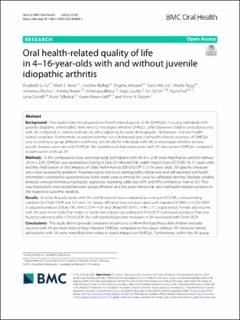| dc.description.abstract | Background
Few studies have investigated oral health-related quality of life (OHRQoL) in young individuals with juvenile idiopathic arthritis (JIA). Aims were to investigate whether OHRQoL differs between children and adolescents with JIA compared to controls without JIA, while adjusting for socio-demographic-, behavioral- and oral health-related covariates. Furthermore, to explore whether socio-behavioral and oral health-related covariates of OHRQoL vary according to group affiliation and finally, specifically for individuals with JIA, to investigate whether disease-specific features associate with OHRQoL. We hypothesized that participants with JIA have poorer OHRQoL compared to participants without JIA.
Methods
In this comparative cross-sectional study participants with JIA (n = 224) were matched to controls without JIA (n = 224). OHRQoL was assessed according to Early Childhood Oral Health Impact Scale (ECOHIS) (4–11-years-olds) and the child version of Oral Impacts on Daily Performances (Child-OIDP) (12–16-years-olds). JIA-specific characteristics were assessed by pediatric rheumatologists and socio-demographic, behavioral and self-reported oral health information collected by questionnaires. Index teeth were examined for caries by calibrated dentists. Multiple variable analyses were performed using logistic regression, reporting odds ratio (OR) and 95% confidence interval (CI). Two-way interactions were tested between group affiliation and the socio-behavioral- and oral health-related variables on the respective outcome variables.
Results
In total, 96 participants with JIA and 98 controls were evaluated according to ECOHIS, corresponding numbers for Child-OIDP was 125 and 124. Group affiliation was not associated with impaired ECOHIS or Child-OIDP in adjusted analyses (OR = 1.95, 95% CI 0.94–4.04 and OR = 0.99, 95% CI 0.46–2.17, respectively). Female adolescents with JIA were more likely than males to report oral impacts according to Child-OIDP. Continued activity or flare was found to adversely affect Child-OIDP, also self-reported outcome measures in JIA associated with Child-OIDP.
Conclusions
This study did not provide consistent evidence to confirm the hypothesis that children and adolescents with JIA are more likely to have impaired OHRQoL compared to their peers without JIA. However, female adolescents with JIA were more likely than males to report impacts on OHRQoL. Furthermore, within the JIA group, adolescents with continued disease activity, flare or reporting pain, physical disability, had higher risk than their counterparts of impaired OHRQoL. | en_US |

